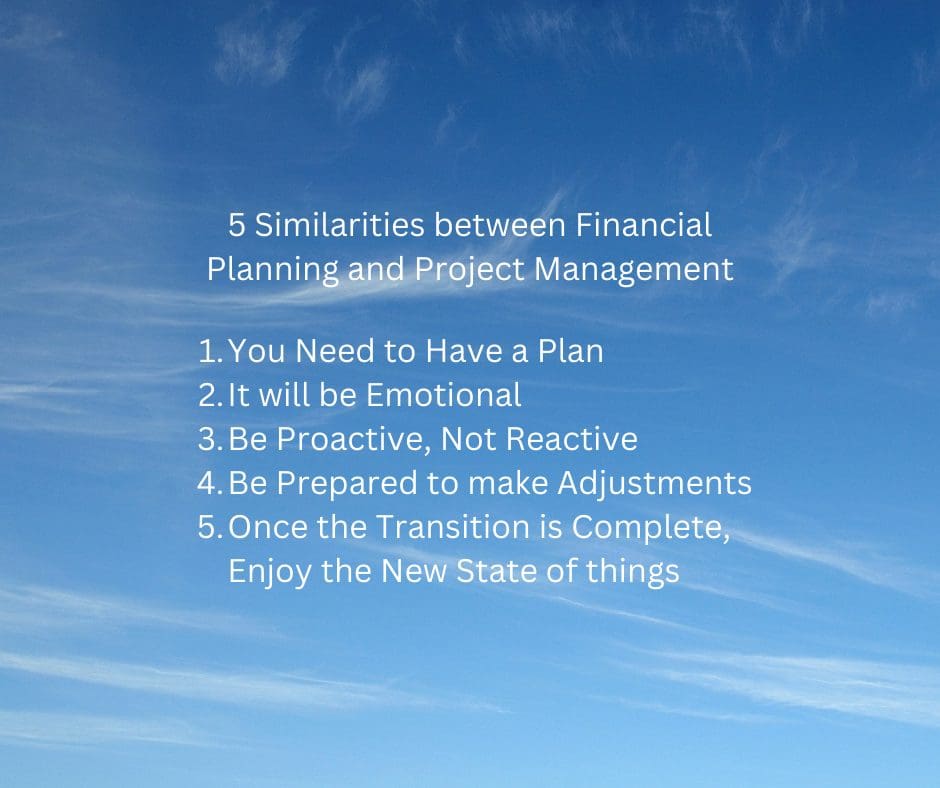If you have ever been through a system migration at your place of work, you know that it will be a bumpy ride. You have set up a Project Management team and spent months, if not years, planning for the transition. Mapped out all potential scenarios and asked all the right questions:
- Do we need a new cost center here or a new workflow there?
- What process changes do we need to make so the new system works better than the old system?
- Have we thought about training all the people who will be required to work in the new system?
- Do we have scripts for how to handle clients in case something does not go as planned?
- Who do I call if something gets lost or does not exist any longer?
- And so many more questions…

I am guessing that this sounds familiar to many of you, who, like me, have been through multiple systems transitions over the years. I was struck by the similarities between these types of transitions; the Project Management work involved, and the Financial Planning services we provide, when we recently went through the transition of custodian platforms from TD Ameritrade to Charles Schwab.
We will detail some of the specifics of the acquisition and integration in the next few paragraphs and then conclude the article with 5 Similarities between Financial Planning and Project Management.
Charles Schwab acquisition and integration of TD Ameritrade
Charles Schwab acquired TD Ameritrade in 2019 and, over the Labor Day weekend 2023, the transition from the TD Ameritrade custodian platform to the Charles Schwab custodian platform took place. A major acquisition like this is built upon the future success of integrating two companies, but that does not mean that such a large system’s transition is going to be smooth for its clients (i.e. companies like us, Runey & Associates Wealth Management), and consequently, for our own clients. Therefore, we decided to be proactive and to put on our Project Management hats from our prior work experiences and plan for the transition.
How did we utilize our Project Management skillsets to prepare for this system migration?
- The first thing we did was communicate the change to our clients. We have done so continuously throughout the year to make sure that this does not take anybody by surprise and to give everyone ample time to ask as many questions as possible.
- Second, we have educated ourselves on the details of the transition and the functionality of the new custodial platform. We learned as much as we could pre-transition.
- Third, as the transition date approached, we captured all the information we could about each of our clients, and their accounts, within TD Ameritrade to ensure that the information in Charles Schwab would match. This allowed us to reconcile between the two sets of information to detect if anything was missing.
So, how did it go? Overall, the process was a success; Charles Schwab and TD Ameritrade handled the transition well, but we still spent numerous hours on the phones during that first week making sure that all the information that was in the old system was also in the new system. We continued to communicate closely with those of our clients who had questions. We worked tirelessly to ensure that there was no information missing and, where the Charles Schwab platform works differently for our clients vs. the TD Ameritrade platform, we informed our clients of new or changed processes as it relates to their accounts and activities. Could there still be something that needs to be fixed down the line? Absolutely, but that should be the exception and not the rule.
5 Similarities between Financial Planning and Project Management
So, how does all this relate to my original statement about similarities between Financial Planning and Project Management? Well, in our opinion, there are many similarities that are worth pointing out that hopefully resonate with you:

1. You Need to Have a Plan
Financial Planning is just that, a plan. But if you don’t have a plan, how do you know what you are aiming for? Same with a systems transition, if you don’t have a well-documented project plan with tasks, milestones, roles and responsibilities (i.e., Project Management), how will you ever complete the transition?
In Financial Planning, the life transition which we mainly focus on in our office is the transition from your working years to your retirement years. This transition will eventually happen whether you like it or not, so why not do your very best to plan for it? We love this part of our job; helping people with one of the most financially and emotionally complex decisions you will ever make in your personal life – how to move from regular paycheck to portfolio paycheck. The earlier you start this Retirement Planning process the better (like Project Management). We primarily work with those age 50 and above to put their pre-retirement plan and retirement transition plan in motion.
2. It will be Emotional
In a systems transition, emotions run high, and ego starts to play a role unless there is a plan in place that everyone has bought into. As we all know, that is not an easy task! It is the same with Financial Retirement Planning. Whether you are single or married, emotions will come into play. Emotions about your money, your life, your spouse, your children, where you are going to live, what you are going to do in retirement, are you ready to let go of your existing identity and RETIRE INTO something else? We enjoy helping our clients to take a step back, to take a moment and work on a plan that will help create a path for the future.
3. Be Proactive, Not Reactive
When you put a project in motion at a corporation, you make sure to answer all the questions, and many more, that we listed in the first paragraph of this article. You have a proper Project Management tool in place and a meeting schedule to make sure the project is moving forward as it should. You are being proactive. We strongly suggest you take the same proactive approach to your own financial life to discover areas that need attention, areas where you are doing well and, to take the next steps towards knowing where you are, where you are going, and how to get there.
4. Be Prepared to make Adjustments
There will be a few bumps and surprises down the road. As with a new IT system, a Financial Plan will not be perfect, but it will be directionally correct. Once you have put pen to paper and taken the step to document the plan, you are way ahead of the game. Research indicates that people who have a plan have a significantly greater chance of reaching their goals than those who do not. Just imagine that you embark on a new project at work without a plan for how to complete it…this simply would not happen. Don’t make that mistake with your own life – put that plan in place and stick to it, adjust it as necessary and allow it to take you where YOU want to go.
5. Once the Transition is Complete, Enjoy the New State of things
Once you are past the initial stages of a system migration and the Project Management tool has been officially closed, the dust has settled, you will start enjoying the new system, or the results of completing a specific project. The same is true with your transition into retirement – there will be quite a few things to complete before and after the transition and then, when everything has calmed down, it will be time to enjoy your new life situation. Make sure you have thought about what you want to do in retirement and then go do it!
Utilizing a professional Project Management approach at work to mitigate potential project risks equates to the Financial Planning work we do to mitigate potential financial risks to our client’s lives.
Someone once said: “expect the best, plan for the worst, and prepare to be surprised”. This is what we do with, and for, our clients every day. If you are not yet a client and would like to learn more about what we can do for you, please visit us at www.raawealth.com and schedule an appointment. We would be honored to speak with you.